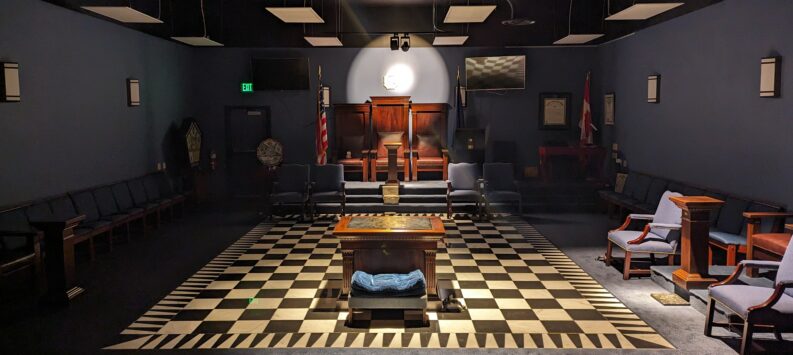Freemasonry, one of the world’s oldest and most renowned fraternal organizations, is built on a foundation of principles and traditions known as the Landmarks of Masonry. These Landmarks serve as the essential elements that define and preserve the identity and continuity of Freemasonry. While there is no universally agreed-upon list of these Landmarks, several key principles are widely recognized and adhered to by Masonic lodges around the globe. This article explores these fundamental Landmarks and their significance within the Masonic fraternity.
Belief in a Supreme Being
A cornerstone of Freemasonry is the requirement that all members profess a belief in a Supreme Being. This principle, often referred to as the belief in the Great Architect of the Universe, underscores the spiritual foundation of the organization. It ensures that Freemasonry is inclusive of men from various religious backgrounds while maintaining a shared spiritual bond.
The Volume of the Sacred Law
An open Volume of the Sacred Law (VSL) is present in every Masonic lodge during meetings. This sacred text, which can be the Bible, Quran, Torah, or any other holy book relevant to the members, symbolizes divine truth and moral guidance. It serves as a constant reminder of the ethical and spiritual commitments Masons make.
The Legend of the Third Degree
The allegory of Hiram Abiff, central to the Master Mason degree, is a fundamental aspect of Masonic ritual. This legend, which tells the story of Hiram’s death and resurrection, imparts important moral and ethical lessons about integrity, loyalty, and the pursuit of truth.
The Symbolic Nature of Freemasonry
Freemasonry is rich in symbols and allegories, which are used to teach moral lessons and promote self-improvement. Symbols such as the square and compasses, the letter ‘G’, and the working tools of a stonemason are integral to Masonic instruction. These symbols transcend language and culture, providing a universal means of conveying Masonic values.
The Secrecy of the Rituals
The modes of recognition—grips, signs, and words—are kept secret among Masons. This secrecy preserves the integrity and solemnity of Masonic ceremonies and strengthens the bonds of trust and brotherhood among members. It also ensures that the profound teachings embedded in the rituals are revealed in a meaningful and impactful manner.
The Three Degrees of Craft Masonry
Freemasonry consists of three primary degrees: Entered Apprentice, Fellow Craft, and Master Mason. Each degree represents a stage of moral and spiritual development, guiding members through a journey of personal growth and enlightenment. These degrees are universally recognized and form the core of Masonic education.
The Autonomy of Lodges
Each Masonic lodge is autonomous, governing its own affairs within the framework of the Grand Lodge. This principle ensures the independence and self-governance of Masonic bodies, allowing them to operate according to local customs and traditions while adhering to the broader Masonic principles.
The Prohibition of Political and Religious Discussions
Discussions of politics and religion are explicitly prohibited within Masonic lodges. This prohibition fosters a neutral environment focused on personal and moral development, free from the divisiveness that such topics can bring. It helps maintain harmony and brotherhood among members of diverse backgrounds and beliefs.
The Equality of Masons
Freemasonry is founded on the principle of equality, recognizing that all Masons are equal regardless of their social, economic, or political status. This principle promotes a sense of brotherhood and mutual respect, ensuring that all members are treated with dignity and fairness.
Conclusion
The Landmarks of Masonry are essential in maintaining the integrity, continuity, and identity of Freemasonry. They provide a framework that guides the moral and spiritual development of its members, ensuring that the core values of the fraternity are preserved and transmitted through generations. By adhering to these Landmarks, Freemasons around the world continue to uphold the principles of brotherhood, charity, and truth, which are at the heart of their ancient and honorable institution.
If you are interested in learning more about Freemasonry, or Mt. Juneau-Gastineaux Lodge, please contact us here.
Further Reading
For those interested in exploring the Landmarks of Masonry in more detail, consider reading works such as:
- “The Principles of Masonic Law” by Albert G. Mackey: This book outlines Mackey’s interpretation of the Masonic Landmarks and provides a comprehensive understanding of Masonic law and tradition.
- Encyclopedia of Freemasonry by Albert G. Mackey: Offers detailed explanations of the landmarks and their historical context.
- Publications from the Masonic Service Association of North America: These resources provide insights into various aspects of Masonic principles and practices.
By delving into these resources, one can gain a deeper appreciation of the timeless principles that define and sustain Freemasonry.


